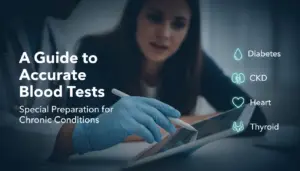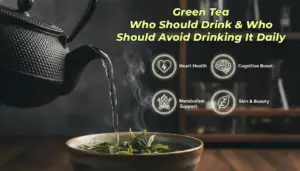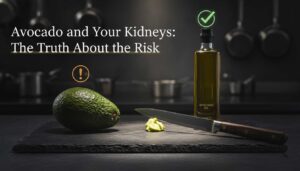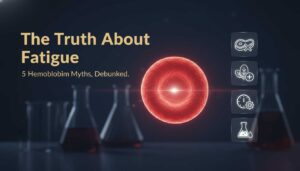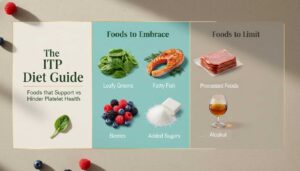Feeling tired by mid-day, losing focus, or cutting workouts short? Low hemoglobin could be part of the problem. This guide gives you 10 proven ways to increase hemoglobin levels naturally, safely. You will build a food-first plan with iron, vitamin C, folate, and B12, and you will learn simple timing habits so coffee, tea, and calcium do not block absorption. When diet is not enough, we explain how to use clinician-aligned supplements with care.
Table of Contents
Hemoglobin is the protein in red blood cells that carries oxygen from your lungs to your brain and muscles. When it drops, thinking feels harder, energy fades, and physical performance falls off. In the United States, iron-deficiency anemia affects millions and is especially common among females, so practical and safe solutions matter. The steps below focus on what works now: real food, smart timing, and targeted support when appropriate, so you can increase hemoglobin naturally and boost hemoglobin levels safely without gimmicks.
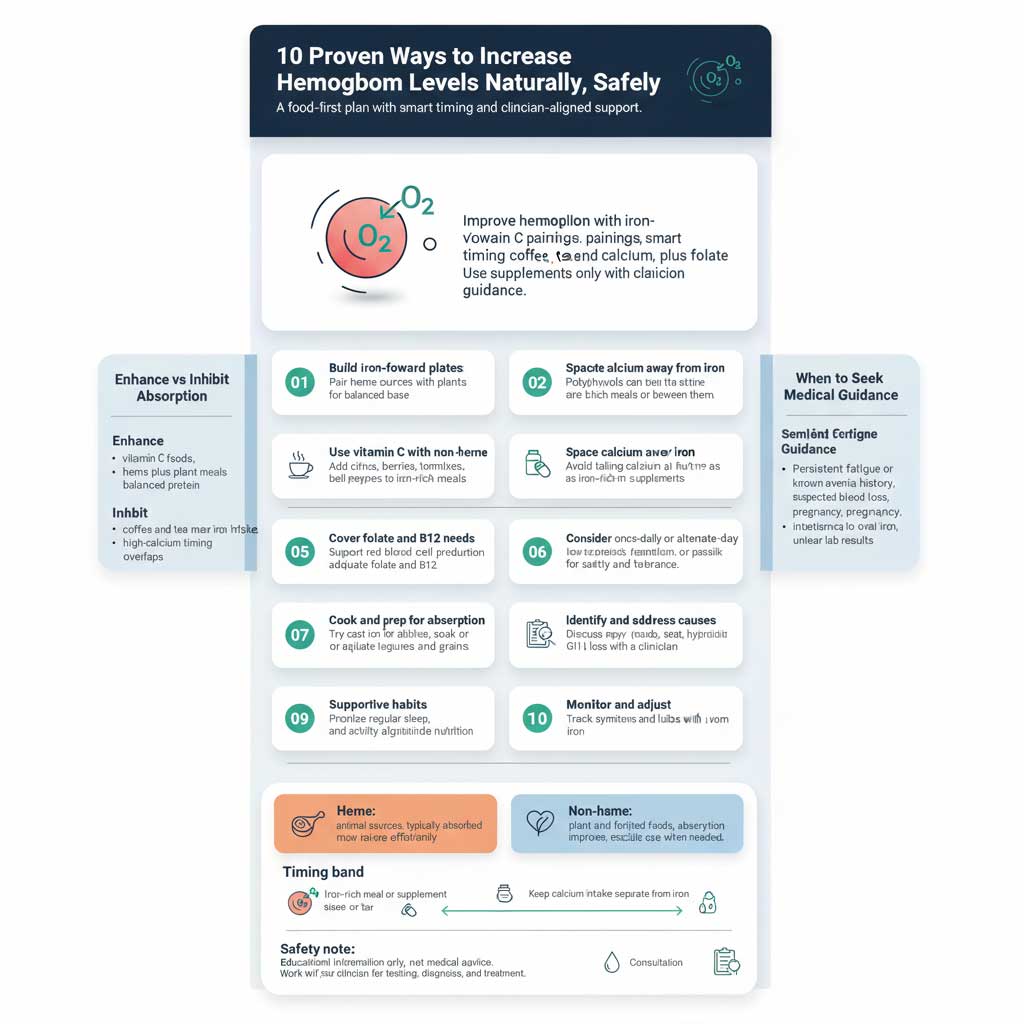
Compliance Note: The information provided here is for educational purposes only and is not a substitute for professional medical advice, diagnosis, or treatment. Always consult a qualified healthcare clinician for any health concerns, especially if you are pregnant, have a chronic illness, or are experiencing persistent symptoms of low hemoglobin.
Data from national health surveys illustrates a clear demographic gap, consistently showing higher anemia prevalence in women of reproductive age and young children compared to adult men.
Core Concepts & Definitions to Understand Your Blood Health
To effectively tackle low hemoglobin, it’s crucial to understand the key players involved in your blood health. This foundational knowledge empowers you to have more informed conversations with your healthcare provider and make more effective dietary choices.
What Hemoglobin Is—and What It Isn’t
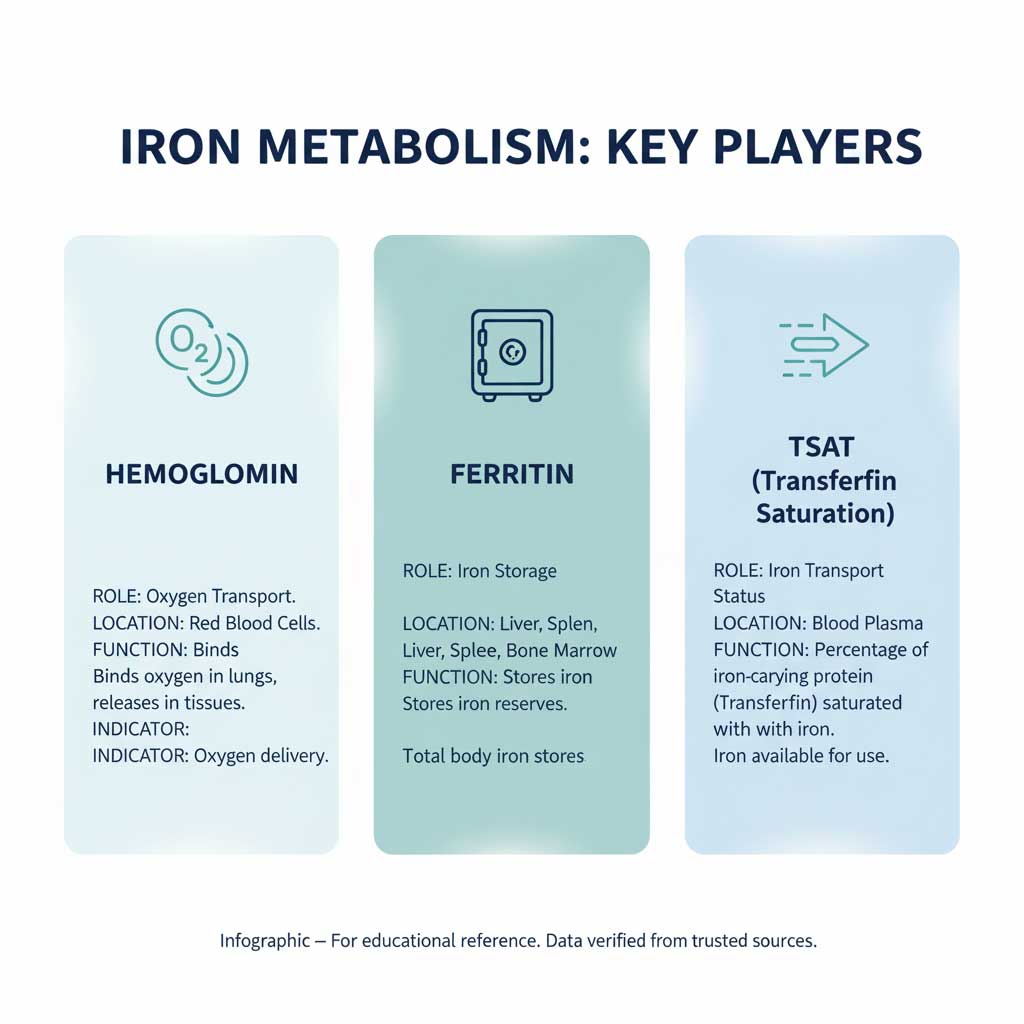
Hemoglobin, often abbreviated as Hb, is the iron-containing protein in your red blood cells that masterfully binds to and transports oxygen. Think of it as the essential delivery truck for oxygen throughout your body’s complex highway system. A low hemoglobin level signifies a reduced oxygen-carrying capacity, but it doesn’t, by itself, diagnose the specific cause.
It’s a critical indicator, but it’s just one piece of a larger diagnostic puzzle. It is often confused with other related markers like ferritin and transferrin saturation, which provide different but complementary insights into your iron status. Understanding the ferritin vs hemoglobin difference is key to a proper diagnosis.
Glossary: Key Blood Health Markers at a Glance
- Hemoglobin (Hb): The oxygen-carrying protein in red blood cells. A low level is a primary indicator of anemia.
- Ferritin: The protein that stores iron in your body. It reflects your body’s iron reserves, like a savings account. Low ferritin is often the first sign of iron depletion.
- Transferrin Saturation (TSAT): This measures how much of the iron-transporting protein is actively carrying iron. It indicates the availability of circulating iron to make new red blood cells. A transferrin saturation low value suggests iron isn’t readily available.
U.S. Snapshot and Who’s Most at Risk
In the United States, iron deficiency remains a significant public health concern. Women of reproductive age are at a substantially higher risk due to menstrual blood loss. Furthermore, prevalence data shows that lower-income groups often experience higher rates of anemia, potentially linked to food insecurity and limited access to the best iron-rich foods for anemia.
Pregnant women, young children, athletes, and individuals with chronic inflammatory diseases or gastrointestinal conditions also represent vulnerable populations who need to be vigilant about their iron status.
How Absorption Works: Heme vs. Non-Heme, Enhancers & Inhibitors
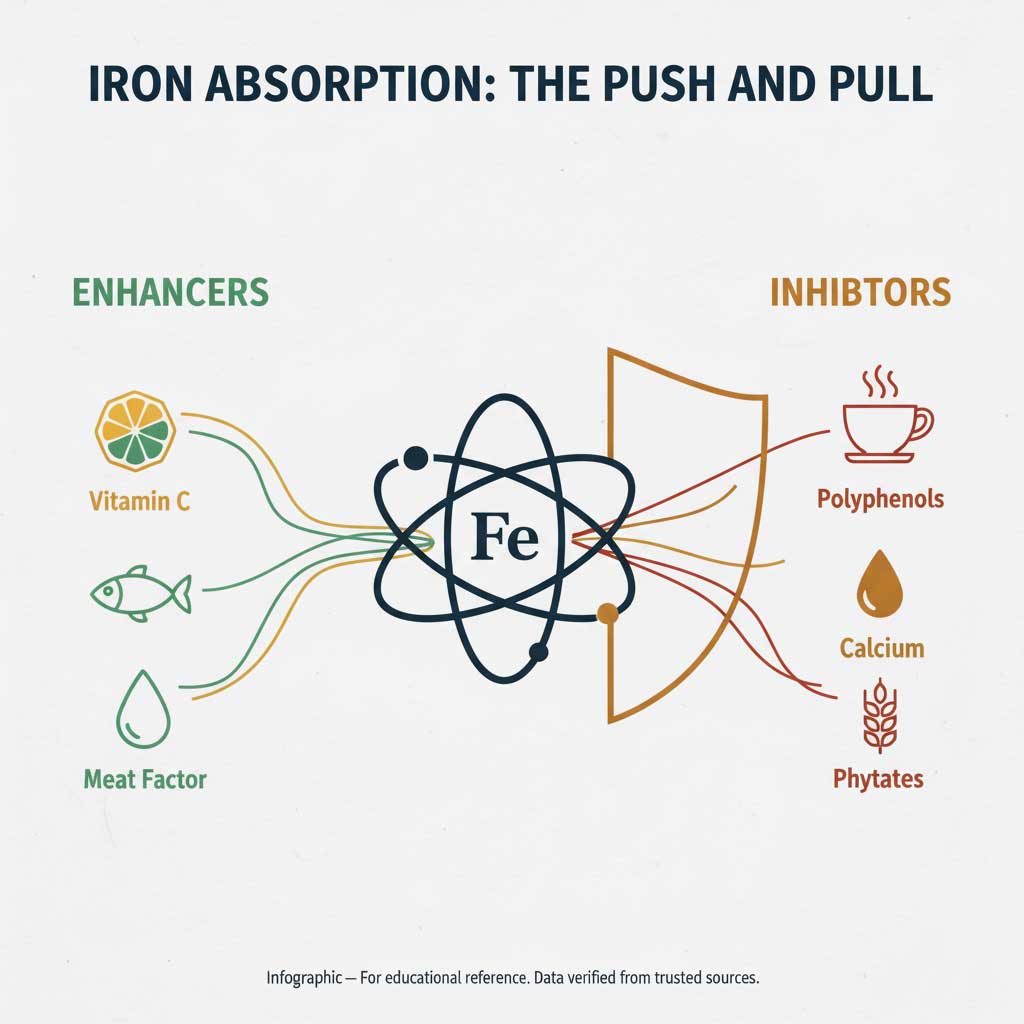
Understanding how your body absorbs iron is fundamental to any strategy designed to increase hemoglobin naturally. Iron from food comes in two primary forms, and your body handles them very differently. This is the core concept behind the heme vs non-heme iron sources distinction.
- Heme Iron: Found exclusively in animal products like meat, poultry, and fish. It is highly bioavailable, meaning your body absorbs it very efficiently, and its absorption is not significantly affected by other dietary components.
- Non-Heme Iron: Found in plant-based foods to increase hemoglobin, such as beans, lentils, spinach, and fortified cereals. Its absorption is much more variable and is heavily influenced by other foods you eat at the same meal.
The mechanism is clear: vitamin C converts non-heme iron into a more usable form, while compounds in tea, coffee, and calcium compete with iron for uptake in the gut.
Latest Evidence & Trends in Iron Management (2024–2025)
The clinical understanding of iron management is constantly evolving. Recent research has refined best practices, moving away from outdated protocols toward more effective and tolerable strategies to boost hemoglobin levels safely.
Oral Iron: Best-Practice Update on Dosing

For decades, the standard advice was to take iron supplements multiple times a day. However, this often led to poor tolerance and side effects. Modern clinical guidance now favors a less-is-more approach. The hormone hepcidin, which blocks iron absorption, rises after an iron dose, making subsequent doses less effective.
This has led to the rise of alternate-day iron dosing (oral). Taking a single dose every other day can keep hepcidin levels lower, potentially leading to better overall absorption with fewer gastrointestinal side effects. When oral iron fails, is not tolerated, or a rapid correction is needed, the question of IV iron vs oral iron becomes a clinical consideration.
Evidence Sidebar: Best Practice Advice
- Modern guidance favors once-daily or alternate-day iron dosing to improve absorption and reduce side effects.
- Always pair oral iron supplements with a source of vitamin C, around 250-500mg.
- Consider IV iron when oral therapies fail, are not tolerated, or malabsorption is present.
Vitamin C Pairing: When and How It Helps
The science is clear: pairing vitamin C for iron absorption is one of the most effective iron deficiency anemia natural remedies. This is especially critical for those relying on plant-based, or non-heme, iron sources. The vitamin acts as a reducing agent, helping your gut absorb the iron more efficiently.
This strategy is practical and food-first. Squeezing a lemon over a lentil soup or having a side of bell peppers with a bean burrito are simple, effective ways to apply this principle. While beneficial, it’s wise to respect safety limits for supplementation.
A Note on Vitamin C Upper LimitsThe tolerable upper intake level for vitamin C for adults is 2,000 milligrams per day. While it’s hard to reach this with food alone, high-dose supplements can cause digestive issues.
Timing Matters: Navigating Polyphenols & Calcium
The timing of your meals and beverages can make or break your iron absorption strategy. As noted, polyphenols in coffee and tea, as well as calcium, are potent inhibitors. The question isn’t just if these substances block iron, but rather can calcium supplements block iron—how to space doses is the critical factor.
A simple rule is to create a two-hour buffer. For example, you might take your iron at 8 AM with orange juice, then have your morning coffee or latte after 10 AM. This simple spacing ensures you get the most out of your iron intake.
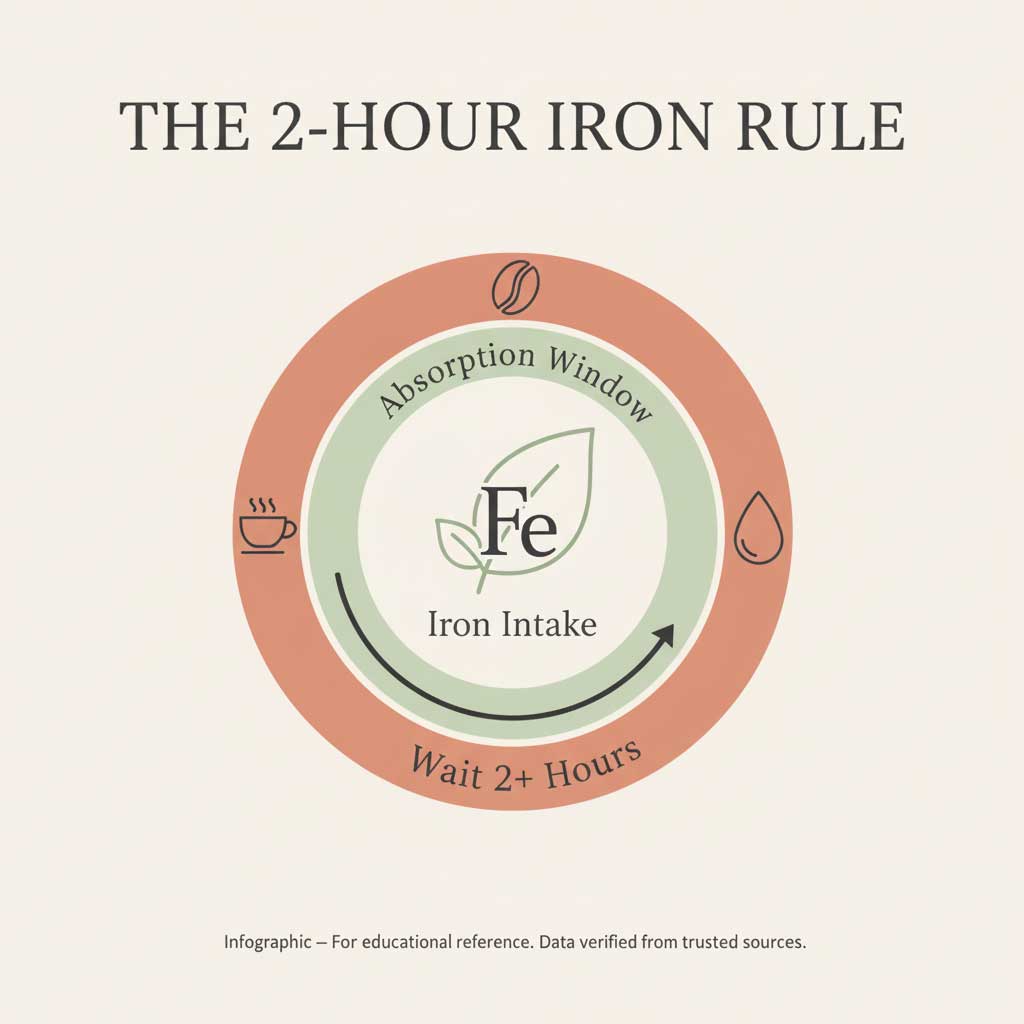
Special Populations: Pregnancy & Clinical Nuance
During pregnancy, iron demands skyrocket to support the growing fetus and expanded maternal blood volume. While many women require supplementation, recommendations for asymptomatic or mild anemia can vary, emphasizing the need for individualized care.
Your obstetrician will guide your care based on your specific lab results and health profile. This personalized approach is crucial for ensuring both maternal and fetal well-being.
Policy Note Box: Understanding “I Statements”An “I statement” from a body like the U.S. Preventive Services Task Force (USPSTF) indicates there is insufficient evidence to recommend for or against a routine service for the general population. This highlights why personalized medical advice from your clinician is paramount, especially during pregnancy.
The 10 Proven Ways to Increase Hemoglobin
Here are actionable, evidence-aligned strategies to help you effectively and safely raise your hemoglobin levels. These methods focus on a holistic approach, starting with nutrition and lifestyle.
1) Build Every Meal Around Iron (Heme + Non-Heme)

The cornerstone of any plan to increase hemoglobin naturally is a diet consistently rich in iron. Make it a goal to include a source of iron with every meal. A balanced plate with both heme and non-heme sources is one of the most effective iron deficiency anemia natural remedies.
Here are some of the best iron-rich foods for anemia:
- Lean Red Meat: A 3-ounce serving of lean beef provides about 2-3 mg of highly absorbable heme iron.
- Poultry & Seafood: Chicken, turkey, and fish like salmon or tuna are excellent heme iron sources.
- Lentils and Beans: One cup of cooked lentils offers over 6 mg of non-heme iron. Kidney beans and chickpeas are also great choices.
- Tofu and Edame: Soy products are among the top vegetarian iron sources that raise hemoglobin fast.
- Dark Leafy Greens: One cup of cooked spinach provides over 6 mg of non-heme iron.
- Fortified Foods: Many breakfast cereals and oatmeals are fortified with 100% of the daily value for iron.
2) Pair Iron with Vitamin C for Maximum Absorption
To unlock the full potential of non-heme iron, always pair it with a source of vitamin C at the same meal. Simple meal pairings include adding bell peppers to a bean salad, squeezing lemon over lentil soup, or enjoying berries with fortified cereal.
This simple food synergy is a powerhouse strategy.
3) Time Coffee, Tea & Calcium Away from Iron
What you drink with your meals matters immensely. To prevent inhibitors from sabotaging your efforts, make a conscious effort to separate them from your main iron sources. This is a critical step to boost hemoglobin levels safely.
- Simple Spacing Rule: Wait at least 1-2 hours after an iron-rich meal before enjoying coffee or tea.
- Calcium Timing: Take calcium supplements or consume dairy-rich snacks between meals rather than with them.
A sample day might involve taking an iron supplement in the morning, having coffee mid-morning, and a calcium-rich yogurt in the afternoon, effectively spacing out each component.
4) Hit Your Folate & B12 Targets
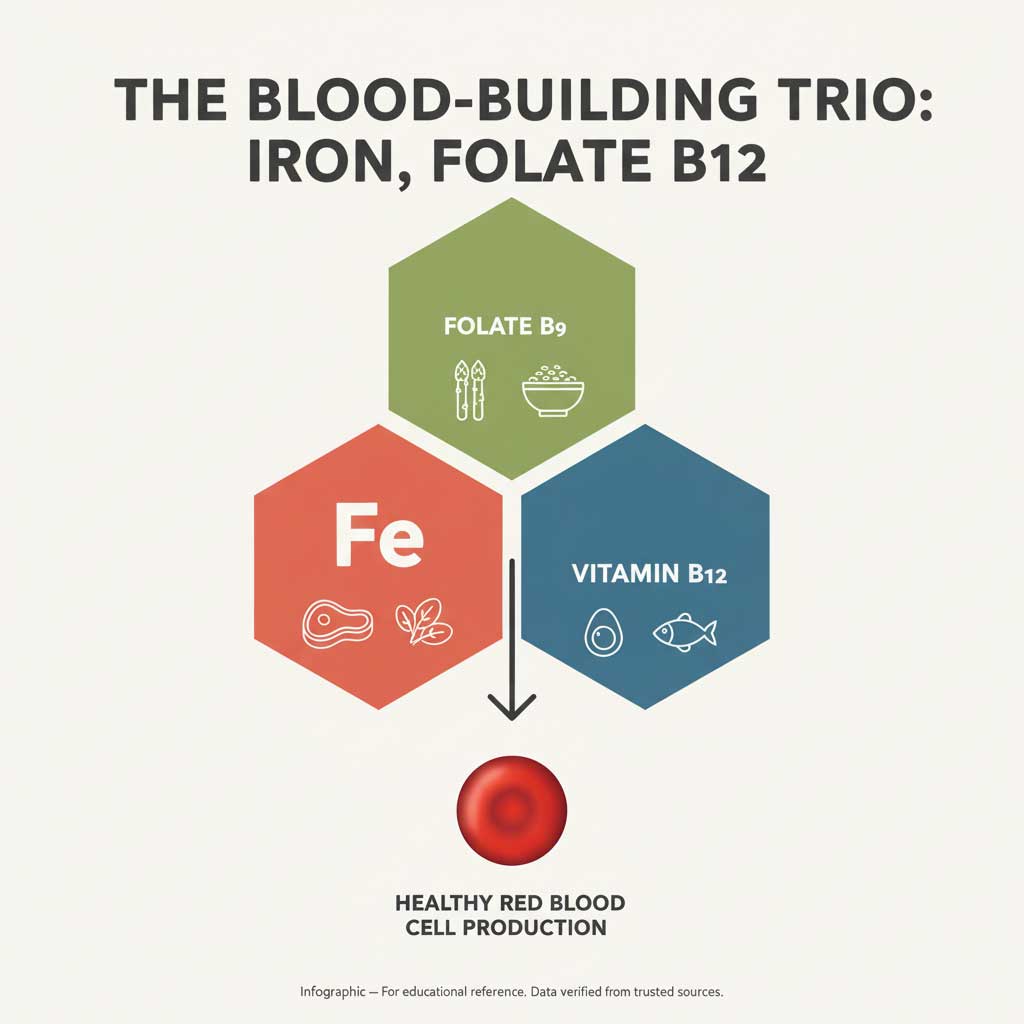
Hemoglobin production is a team effort. It requires more than just iron. Folate, also known as Vitamin B9, and Vitamin B12 are also essential for forming healthy red blood cells. A deficiency in either can cause anemia, even with normal iron stores, which is why understanding the role of folate and B12 for hemoglobin is crucial.
- Folate-Rich Foods: Leafy greens, asparagus, Brussels sprouts, beans, and fortified grains.
- B12-Rich Foods: Primarily found in animal products. Vegans and vegetarians must be vigilant, incorporating B12-fortified foods like nutritional yeast or plant milks, or a reliable supplement.
Micro-Checklist: Labs to Discuss with Your Clinician
- Complete Blood Count (CBC)
- Ferritin (iron stores)
- Transferrin Saturation (TSAT) (available iron)
- Vitamin B12
- Folate (Serum or RBC)
5) Cook Smart: Use Cast Iron & Proper Food Prep
Your kitchen habits can subtly influence your iron intake. Two simple techniques can give you an extra edge.
- Cook in Cast Iron: Cooking acidic foods like tomato sauce or chili in a cast-iron skillet can significantly increase the iron content of your meal. The acid helps leach iron from the pan into your food.
- Soak and Sprout: For legumes, grains, and seeds, soaking or sprouting them before cooking can reduce their phytate levels. Lowering phytates helps improve the bioavailability of non-heme iron.
6) Use Once-Daily or Alternate-Day Oral Iron (If Prescribed)
When diet alone isn’t enough, your clinician may prescribe an oral iron supplement. Adhering to modern dosing protocols is key for success and comfort. The research on alternate day vs daily iron—what works better for absorption—points towards less frequent dosing for many individuals.
- Modern Dosing: Take your iron as prescribed, which may be once daily or every other day.
- Vitamin C Boost: Take your pill with a glass of orange juice or a 250-500mg vitamin C tablet to maximize uptake.
- Start Low, Go Slow: Your provider may recommend starting with a lower dose to assess your tolerance before increasing it.
“Talk to Your Clinician” Checklist
- Which form of iron is best for me (e.g., ferrous sulfate, bisglycinate)?
- How should I manage side effects like nausea or constipation?
- What is the expected timeline for re-testing my levels?
7) Address Blood Loss & Underlying Causes
Low hemoglobin is often a symptom, not the root disease. To achieve a lasting solution, you must identify and address the underlying cause. Simply adding more iron without fixing the “leak” is an uphill battle. If you experience persistent fatigue despite dietary changes, it’s crucial to seek a medical evaluation to investigate potential underlying causes.
- Heavy Menstrual Bleeding: A leading cause of iron deficiency in premenopausal women.
- Frequent Blood Donation: Donating too often can deplete iron stores faster than they can be replenished.
- Gastrointestinal (GI) Bleeding: Ulcers, polyps, or other conditions can cause slow, chronic blood loss.
- Malabsorption Disorders: Celiac disease or inflammatory bowel disease can impair your gut’s ability to absorb iron.
8) Align Your Lifestyle: Sleep, Hydration, and Activity
While nutrition is the primary driver, a supportive lifestyle fosters an environment where your body can thrive. Using a simple habit tracker in a journal or app can help you stay consistent with these supportive changes.
- Prioritize Sleep: Quality sleep is essential for hormonal balance and cellular repair, which supports overall health and energy.
- Stay Hydrated: Proper hydration is crucial for maintaining healthy blood volume and circulation.
- Move Mindfully: Moderate, consistent exercise can stimulate red blood cell production. However, avoid intense exercise if you are severely anemic, as it can worsen fatigue.
9) Monitor Your Progress the Right Way
Restoring hemoglobin and iron stores is a marathon, not a sprint. Tracking your progress involves monitoring both subjective symptoms and objective lab values. Knowing the typical timeline to raise hemoglobin by 1 g/dL naturally, which is often two to four weeks or more, helps set realistic expectations.
- Typical Timeline: With effective treatment, you might see a hemoglobin rise of about 1 g/dL every 2-4 weeks. Ferritin levels will rise more slowly.
- Symptom Tracking: Keep a simple journal to note changes in energy, focus, and shortness of breath.
- Lab Follow-Ups: Your clinician will schedule follow-up blood tests to ensure the treatment plan is working effectively.
10) Know When IV Iron Is the Safer, Faster Route
In certain clinical situations, oral iron isn’t the best option. Intravenous iron bypasses the gut entirely, delivering iron directly into the bloodstream for a faster and more potent effect. The decision to move to IV iron is based on a clear escalation pathway: if oral iron isn’t tolerated or isn’t working, IV therapy is the next logical step to ensure your safety and well-being.
- Criteria for IV Iron:
- Severe intolerance to oral iron supplements.
- Poor or no response to a consistent oral iron regimen.
- Gastrointestinal conditions that prevent absorption.
- A clinical need for rapid repletion, for instance, before major surgery.
- Understanding when to switch from oral to IV iron for anemia is a decision made with your healthcare provider.
Comparison Tables for Clarity
Visual comparisons can simplify complex information, making it easier to understand your choices.
Heme vs. Non-Heme Iron: Absorption & Food Sources

| Type | Core Sources (USA) | Typical Absorption Rate | Pros | Considerations |
| Heme Iron | Lean beef, poultry, lamb, seafood (clams, oysters) | 15-35% | Highly bioavailable; absorption is less affected by dietary inhibitors. | Higher cost; not suitable for vegetarian/vegan diets. |
| Non-Heme Iron | Beans, lentils, tofu, spinach, fortified cereals, nuts | 2-20% | Budget-friendly; abundant in plant-based diets; versatile. | Absorption is highly dependent on enhancers like Vitamin C and inhibitors. |
This table highlights why a strategy to raise hemoglobin quickly (naturally) often involves including heme iron or being extremely diligent with non-heme pairings.
Oral vs. IV Iron: A Clinical Comparison
| Approach | Primary Use Case | Dosing Style & Considerations | Speed of Repletion | Common Tolerance Issues | Who Decides |
| Oral (Daily) | Mild to moderate iron deficiency with good gut tolerance. | Once daily, often with Vitamin C. | Moderate | Can cause nausea, constipation, or stomach upset. | Clinician-guided |
| Oral (Alternate-Day) | Patients with intolerance to daily dosing; may improve absorption. | Every other day + Vitamin C. | Moderate | Often better tolerated than daily dosing; fewer GI side effects. | Clinician-guided |
| IV Iron | Oral therapy failure, malabsorption, or need for rapid repletion. | Administered as an infusion in a clinical setting. | Fast | Small risk of infusion reactions; requires clinical monitoring. | Specialist/Clinic |
This comparison illustrates the modern, nuanced approach to iron supplementation. Intravenous iron is used only when clinically indicated.
Case Studies & Real-World Scenarios
Applying these principles in real life can help illustrate their effectiveness.
Food-First Turnaround (Omnivore)
A 35-year-old woman with mild anemia focuses on a 4-week meal plan emphasizing both heme and non-heme iron. Her weekly menu featured items like iron-fortified oatmeal with berries, turkey and spinach salads, and lean beef chili. By spacing her morning coffee two hours after breakfast, she sees her energy levels improve significantly before her follow-up labs show a positive upward trend.
Vegan Strategy with B12 Vigilance
A 28-year-old vegan experiencing fatigue learns about vegetarian iron sources that raise hemoglobin fast. They build meals around lentil soup with lemon juice, tofu stir-fries with broccoli and bell peppers, and sprouted grain toast. Crucially, their shopping list always includes B12-fortified nutritional yeast and plant milks to address both potential causes of anemia.
Donation Readiness Micro-Case
A frequent blood donor notices it’s taking longer for his hemoglobin to recover. He learns to space his donations further apart and focuses on an iron-rich diet for two weeks before and after donating. He uses the safe hemoglobin range and donation eligibility USA guidelines as a personal readiness check, not a health target.
Callout Box: U.S. Blood Donation EligibilityIn the U.S., minimum hemoglobin levels for donation are typically 12.5 g/dL for females and 13.0 g/dL for males. These are safety thresholds for donation, not optimal levels for everyday health and performance.
Pregnancy Nuance: The Individualized Approach
A pregnant woman’s routine bloodwork shows borderline-low hemoglobin. She discusses the results with her OB-GYN. Given she has no symptoms, they agree on a shared clinical decision: first, intensify her dietary iron intake with a focus on foods to increase hemoglobin, then re-check her levels in four weeks before considering a supplement.
Tracking Your Progress: Helpful Tools and Apps
Leveraging technology can help you stay on track and monitor your progress effectively.
| Tool/Platform | What It Helps With | Best For | Important Notes |
| Food Logging Apps | Tracking daily intake of iron, vitamin C, calcium, and timing. | Individuals on specific diets or those needing detailed tracking. | Use apps with verified databases, such as Cronometer, for nutrient accuracy. |
| Health Apps | Centralizing lab data like Hb and ferritin from clinic portals. | Anyone wanting to visualize their health trends over time. | Manually input lab results from Apple Health or Google Fit to create a personal health record. |
| Period/Donation Trackers | Monitoring menstrual cycle length/flow and donation frequency. | Menstruating individuals and frequent blood donors. | Helps identify patterns that may contribute to iron loss. |
| Clinic Patient Portals | Accessing lab results, communicating with your provider, scheduling follow-ups. | Anyone undergoing treatment with oral or IV iron. | The most reliable source for your official lab results and clinical advice. |
Summary & Key Takeaways
To increase hemoglobin naturally and safely, a multi-faceted approach centered on diet and lifestyle is the most effective path forward. This involves consistently consuming iron-rich foods, strategically pairing them with vitamin C to enhance absorption, and carefully timing them away from inhibitors like coffee, tea, and calcium. Addressing underlying causes of blood loss and ensuring adequate folate and B12 for hemoglobin production are also crucial.
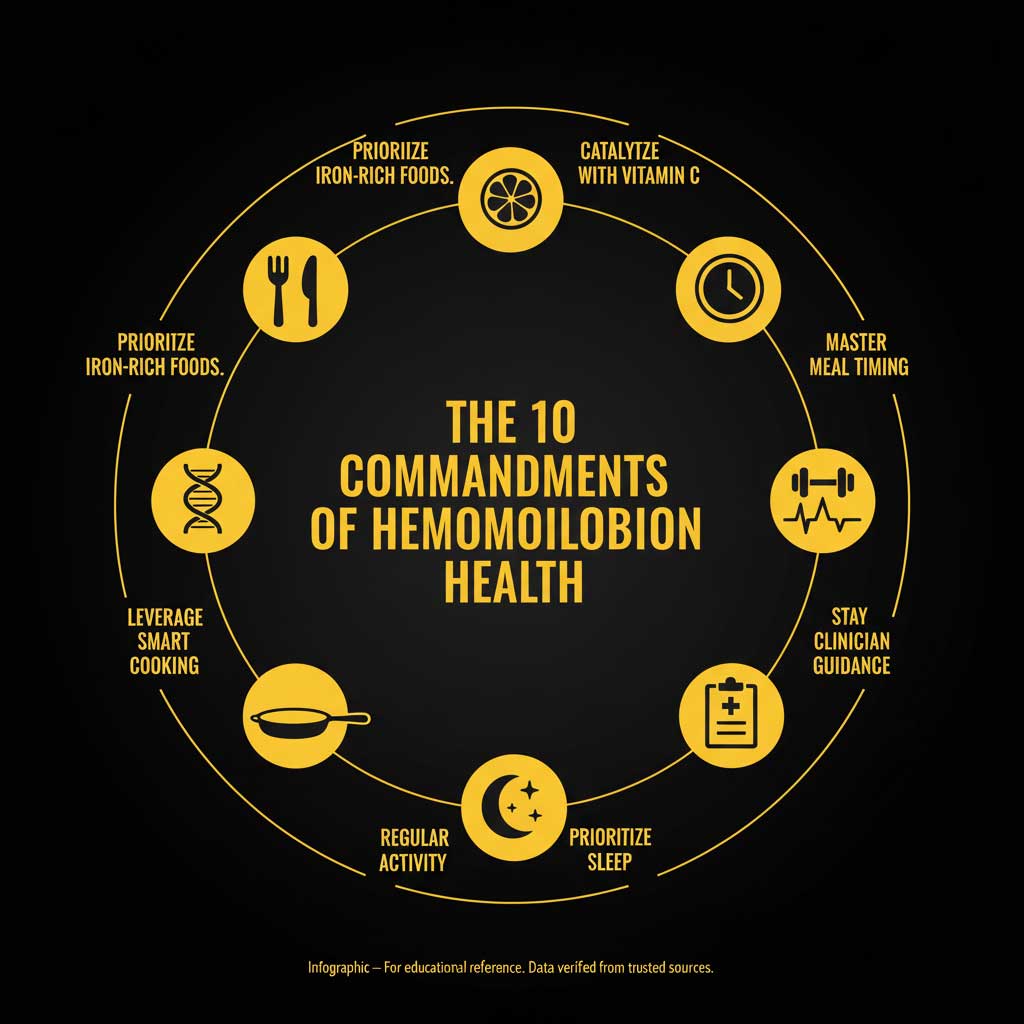
For those requiring supplements, modern alternate-day iron dosing (oral) can improve tolerance. Ultimately, monitoring your progress with your clinician and understanding when IV iron is necessary is key to safely restoring your hemoglobin, reclaiming your energy, and optimizing your focus.
- Recap: The 10 Proven Ways
- Build every meal around iron-rich foods to increase hemoglobin.
- Always pair iron sources with vitamin C for iron absorption.
- Time coffee, tea, and calcium away from your iron intake.
- Ensure you have adequate folate and B12 levels.
- Use smart cooking techniques like cast iron and soaking/sprouting.
- Follow modern oral iron dosing if prescribed by your clinician.
- Work with your doctor to address any underlying causes of blood loss.
- Align your lifestyle with supportive habits like quality sleep and hydration.
- Monitor your symptoms and lab progress with your healthcare team.
- Understand when IV iron is the appropriate next step in treatment.
Frequently Asked Questions (FAQs)
How fast can hemoglobin increase naturally without pills?
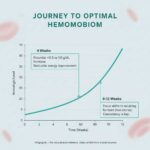
The rate depends on the severity of the deficiency and dietary consistency. With a highly optimized diet focused on the best iron-rich foods for anemia, you might see a gradual increase of 0.5 to 1 g/dL over 4-6 weeks, but it can be a slow process.
What are the best foods to increase hemoglobin quickly?

For the fastest absorption, heme iron sources like lean red meat, oysters, and clams are superior. For plant-based options, lentils, spinach, and fortified cereals, when strictly paired with vitamin C, are excellent choices.
Do coffee, tea, or calcium block iron—and how should I time them?
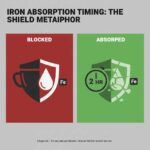
Yes, they are significant inhibitors. To maximize absorption, wait at least 1-2 hours after your iron-rich meal or supplement before consuming coffee, tea, milk, or calcium supplements. This simple timing trick makes a huge difference.
Is alternate-day iron better than daily?

For many people, yes. Research suggests alternate-day iron dosing often causes fewer gastrointestinal side effects, such as constipation and nausea, and may lead to better long-term absorption by keeping the iron-blocking hormone hepcidin lower.
Hemoglobin vs. ferritin: which number should I track?

You should track both. Hemoglobin reflects your blood’s current oxygen-carrying capacity—your “spending cash”—while ferritin reflects your body’s total iron stores—your “savings account.” A complete picture requires knowing both.
How much iron per day should U.S. adults get?

The Recommended Dietary Allowance (RDA) for adults 19-50 is 8 mg/day for men and 18 mg/day for women. Pregnant women need 27 mg/day.
When should I ask my doctor about IV iron?
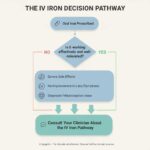
You should discuss IV iron if you cannot tolerate oral supplements due to severe side effects, if your hemoglobin levels are not improving despite consistent oral therapy, or if you have a condition like celiac disease that impairs absorption.
Are vegetarian sources enough to raise hemoglobin?

Absolutely. A well-planned vegetarian or vegan diet that emphasizes iron-rich plant foods, consistently pairs them with vitamin C, and minimizes inhibitors can effectively raise hemoglobin levels. It simply requires more careful planning.
What are safe hemoglobin levels to donate blood in the U.S.?
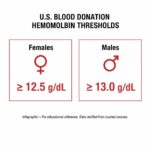
The minimum safe hemoglobin range and donation eligibility USA standards are generally 12.5 g/dL for women and 13.0 g/dL for men. These are safety cutoffs for donating, not necessarily optimal levels for daily energy and performance.
Which fruits are best for helping iron absorption?
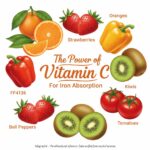
Fruits high in vitamin C are the best partners for iron-rich meals. Top choices include citrus fruits like oranges and grapefruit, strawberries, kiwi, cantaloupe, and even bell peppers and tomatoes, which are botanically classified as fruits.
Can a folate or B12 deficiency look like iron deficiency?

Yes. A deficiency in either folate or B12 can cause megaloblastic anemia, which presents with similar symptoms like fatigue, weakness, and shortness of breath. This is why a comprehensive blood panel is crucial for an accurate diagnosis.
Does cooking in a cast-iron skillet really help?

Yes, it can provide a modest but meaningful boost, especially with acidic foods. Studies have shown that cooking foods like tomato sauce in cast iron can increase their iron content, contributing to your overall daily intake.



